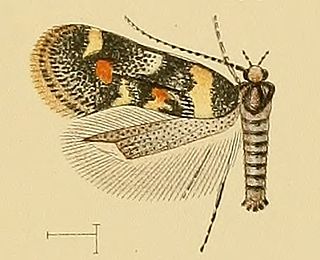Related Research Articles

Nartheciaceae is a family of flowering plants. The APG III system places it in the order Dioscoreales, in the clade monocots. As circumscribed by APG IV (2016) it includes 35 species of herbaceous plants in the following five genera:

Aletris, the colicroot, colicweed, crow corn, or unicorn root, is a genus of flowering plants in the family Nartheciaceae, native to North America and to eastern and southeastern Asia, especially China. It was used as a component in Lydia Pinkham's original Vegetable Compound.

Chrysoesthia drurella is a moth from the family Gelechiidae. In is found in most of Europe, Russia and North America.

Chrysoesthia is a genus of moths in the family Gelechiidae.
Chrysoesthia sexguttella, common name the orache leafminer moth, is a moth in the family Gelechiidae. It is found in all of Europe, east to southern Siberia, as well as the north-eastern parts of North America, where it might be an introduced species.

Chrysoesthia boseae is a moth of the family Gelechiidae. It is found on the Canary Islands.
Chrysoesthia eppelsheimi is a moth of the family Gelechiidae. It is found in France, Germany and Switzerland.
Chrysoesthia verrucosa is a moth of the family Gelechiidae. It is found in the Czech Republic, Slovakia, Austria, Hungary and northern Italy. There are also records from Germany and it is possibly also present in Poland.
Chrysoesthia falkovitshi is a moth of the family Gelechiidae. It is found in Ukraine, Russia and Mongolia. The habitat consists of calcareous Artemisia steppes.
Chrysoesthia gaditella is a moth of the family Gelechiidae. It is found in Portugal, Spain and Algeria.

Aletris farinosa, called the unicorn root, true unicorn, crow-corn, white colic-root or white stargrass, is a plant species found across much of the eastern United States. It has also been reported from the southern part of Ontario, Canada. It is known from every state east of the Mississippi River except Vermont, as well as Texas, Oklahoma, Arkansas and Louisiana. Its native habitats include moist peaty, sandy or gravelly areas.
Chrysoesthia candidella is a moth of the family Gelechiidae. It is found in Tunisia.
Chrysoesthia compositella is a moth of the family Gelechiidae. It is found in Algeria.
Chrysoesthia halymella is a moth of the family Gelechiidae. It is found in Palestine.
Chrysoesthia isocharis is a moth of the family Gelechiidae. It is found in South Africa.
Chrysoesthia parilis is a moth of the family Gelechiidae. It is found in Ethiopia.
Chrysoesthia stipelloides is a moth of the family Gelechiidae. It is found in South Africa (KwaZulu-Natal) and Madagascar.
Chrysoesthia longifibriata is a moth of the family Gelechiidae. It is found in the Russian Far East, where it has been recorded from the southern part of Primorsky Krai.
Chrysoesthia luteola is a moth of the family Gelechiidae. It is found in the Russian Far East, where it has been recorded from the southern part of Primorsky Krai.
References
- ↑ Fauna Europaea
- ↑ lepiforum.de
 This article incorporates text from this source, which is in the public domain .
This article incorporates text from this source, which is in the public domain .